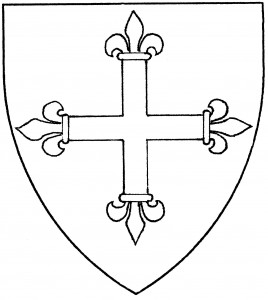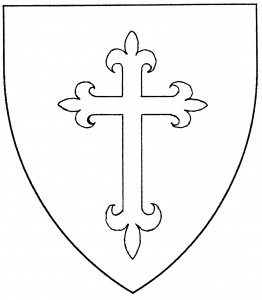The “cross flory” or “cross fleury” was originally an artistic variant of the cross patonce. As a distinct form, it dates from c.1300, in the arms of Lamplow [ANA2 314]. The distinction may be granted for the sake of the artist, but no heraldic difference is granted.
The “cross floretty” is a further outgrowth of the cross flory, with the fleurs-de-lys issuant from the ends of a cross couped. It’s a period variant, found in the arms of Carlisle, c.1455 [Scots 49v]. The cross floretty’s limbs may be straight, or splayed as a “cross formy floretty” (or “cross formy flory at the ends”). The distinction between a cross floretty, cross flory, and cross patonce may be blazoned for the sake of the artist, but no heraldic difference is granted between them.
The “cross of Cleves” is said to be an alternative blazon for the “Latin cross flory”; however, Your Author has found no examples of the term’s use in blazon outside the Society.
Godfrey de Calverley bears: Sable, in saltire five crosses fleury Or.
Constanza Raffaella dall’Oriente bears: Vert semy-de-lys, a Latin cross floretty Or.
Paul Puissant bears: Sable, three crosses of Cleves argent, on a chief dovetailed Or three torteaux.


